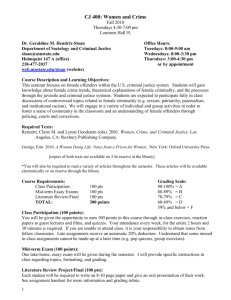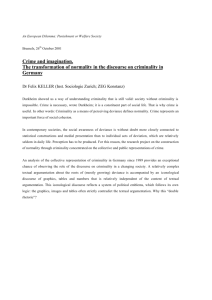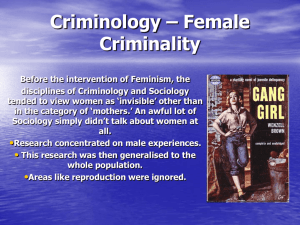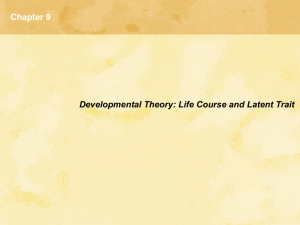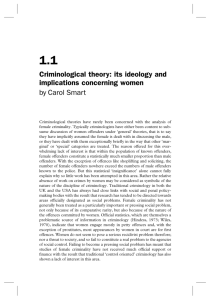Chapter Nine
advertisement
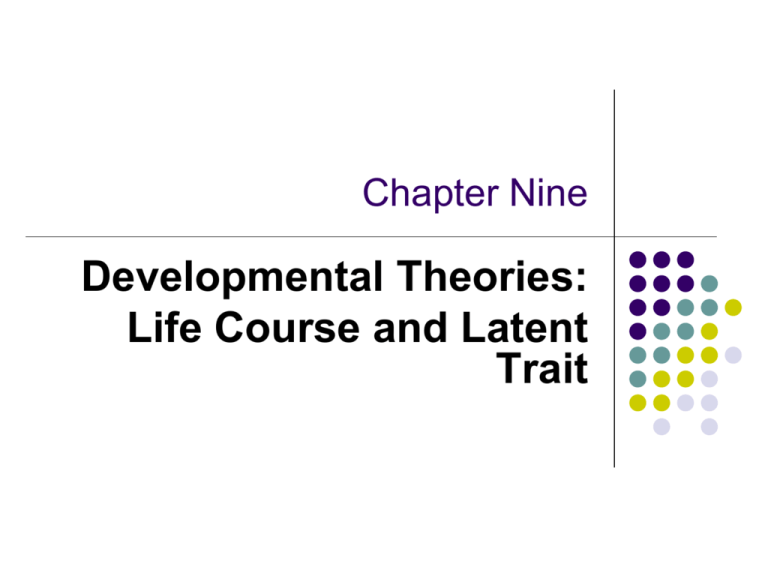
Chapter Nine Developmental Theories: Life Course and Latent Trait Developmental Theory The view that criminality is a dynamic process, influenced by social experiences as well as individual characteristics Developmental factors include biological, social, and psychological structures and processes Attempts to provide a more global vision of a criminal career encompassing its onset, continuation, and termination Difference between this theory and many others is that it attempts to explain what prompts one person to engage in persistent criminal activity while another finds a way to steer clear of crime Questions of Developmental Theory Why do people begin committing antisocial acts? Why do some stop while others continue? Why do some escalate the severity of their criminality while others deescalate and commit less serious crimes as they mature? What causes people to begin to commit crime again once they have stopped? Why do some criminals specialize? Life Course Theories Views that criminality is a dynamic process Individual characteristics, traits, and social experiences influence this process Theoretical views studying changes in criminal offending patterns over a person’s entire life As people travel through their life course they are exposed to perceptions and experiences and thus their behavior may change as well Considered integrated theories Life Course Concepts Problem Behavior Syndrome (PBS) Pathways to crime Age of onset/Continuity of Crime Adolescent-limited and life-course persisters Problem Behavior Syndrome (PBS) A cluster of antisocial behaviors which may include: Family dysfunction Sexual and physical abuse Substance abuse Smoking Precocious sexuality and early pregnancy Educational underachievement Suicide attempts Sensation seeking Unemployment Crime Pathways to Crime Authority conflict pathway Covert pathway Path to a criminal career that begins with early stubborn behavior that leads to defiance and ultimately authority avoidance Path to a criminal career that begins with minor underhanded behavior that leads to property damage and eventually escalates to more serious forms of criminality Overt pathway Path to a criminal career that escalates to aggressive acts, leading to physical fighting and eventually escalates to violent crime Age of Onset/Continuity of Crime The earlier the onset of criminality, the more frequent, varied, and sustained the criminal career Poor parental discipline and monitoring are keys to the early onset of criminality Continuity and desistance Poor parental discipline and monitoring are a key to the early onset of criminality Gender and desistance For males early antisocial behavior is linked to later problems at work and involvement with drugs For females early antisocial behavior is linked to relationship problems, depression, tendency to commit suicide Adolescent-Limited and Life-Course Persisters Adolescent limited offender Considered “typical teenagers” Engage in rebellious teenage behavior They eventually reduce their offending around 18 Life course persistent offender Begin their offending at a very early age Continue to offend well into adulthood A small group of offenders Age-Graded Theory Individual traits and childhood experiences are important to understand the onset of delinquent and criminal behavior They alone cannot explain the continuity of crime into adulthood Experiences in young adulthood and beyond can redirect criminal paths Repeat negative experiences create cumulative disadvantage Positive life experiences can help a person become reattached to society (social capital) Delinquents can choose to “go straight” Find more conventional paths more beneficial and rewarding Factors That Increase the Likelihood of Criminality Weak social bonds Accumulation of deviant peers Labeling by the justice system Unemployment or underemployment Long-term exposure to poverty Latent Trait Theories Some people have a personal attribute or characteristic that controls their inclination or propensity to commit crime This disposition is often called the “latent trait” It may be present at birth or established early in life Though the propensity to commit crime is stable, the opportunity to commit crime fluctuates over time Latent Traits Defective intelligence Damaged or impulsive personality Genetic abnormalities Physical-chemical functioning of the brain Environmental influences on brain function Types of Latent Trait Theories Crime and human nature Personal traits may outweigh the importance of social variables as predictors of criminal activity Traits influence the crime-noncrime choice General theory of crime (self-control theory) The most prominent latent trait theory Shifted focus from social control to self control The view that the cause of delinquent behavior is an impulsive personality Those who are impulsive may find that their bond to society is weak Analysis of the General Crime Theory Explains why some people who lack self-control can escape criminality and why some might not escape Some criticisms that remain unanswered Tautological Different classes of criminals Ecological differences Racial and gender differences Moral beliefs Peer influence People change Effective parenting Modest relationship Cross-cultural differences Misreads human nature One of many causes Some criminals are not impulsive Policy Implications of Developmental Theories Multi-systematic treatment efforts designed to provide at-risk youth with personal, social, educational, and family services SMART Fast Track



